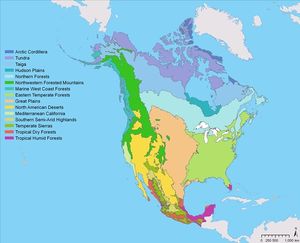Ecoregions of North America (CEC)
| Topics: |
This article is part of the Ecoregions Collection
This article presents an overview of the ecoregion classification system for North America that was developed by the Commission for Environmental Cooperation Working Group (CEC) in 1997. The mapping presented here is built upon earlier efforts that had begun individually in all the United States, Mexico, and Canada. Developing and refining a framework for the study of North American ecological regions was the product of research and consultation between federal, state, provincial and territorial agencies. The Canadian Council on Ecological Areas (CCEA) was the initial group that led and coordinated the development of a North American ecosystem framework in response to initiatives of the Trilateral Committee on Environmental Information. The latter was established by the governments of Canada, Mexico and the United States to foster ways of applying an ecological approach to common North American environmental concerns. Its work was guided by existing national efforts to characterize and report on the sustainability of ecosystems. A more detailed discussion of the project is presented here (Description of the Ecoregions of North America (CEC)).
Contents
Level I Ecoregions
North America has been broken down into 15 broad, level I ecological regions. These highlight major ecological areas and provide the broad backdrop to the ecological mosaic of the continent, putting it in context at global or intercontinental scales:
- Arctic Cordillera
- Tundra (Tundra ecoregion (CEC))
- Taiga (North American taiga)
- Hudson Plains
- Northern Forests
- Northwestern Forested Mountains
- Marine West Coast Forests
- Eastern Temperate Forests
- Great Plains
- North American Deserts
- Mediterranean California
- Southern Semi-Arid Highlands
- Temperate Sierras
- Tropical Dry Forests
- Tropical Humid Forests
Level II Ecoregions
Fifty-two level II ecological regions are delineated that provide a more detailed description of the large ecological areas nested within the Level I regions. For example, the Tropical Humid Forests (Ecoregions of North America (CEC)) of level I is the region covering coastal portions of the United States and Mexico, and is composed of six level II regions. Level II ecological regions are useful for national and subcontinental overviews of physiography, wildlife, and land use.
A detailed classification and description of the Level II ecoregions is available here.
Level III ecoregions of the United States (Ecoregions of North America (CEC))
Level IV ecoregions of the United States (Ecoregions of North America (CEC))
Further reading
- Commission for Environmental Cooperation, Ecological Regions of North America--Toward a Common Perspective, (Quebec, Canada, 1997), ISBN 2-922305-18-X
- United States Environmental Protection Agency, Western Ecology Division, Ecoregion Maps and GIS Resources, Accessed 1 May 2009.
| Disclaimer: This article is taken wholly from, or contains information that was originally published by, the Commission for Environmental Cooperation. Topic editors and authors for the Encyclopedia of Earth may have edited its content or added new information. The use of information from the Commission for Environmental Cooperation should not be construed as support for or endorsement by that organization for any new information added by EoE personnel, or for any editing of the original content. |
